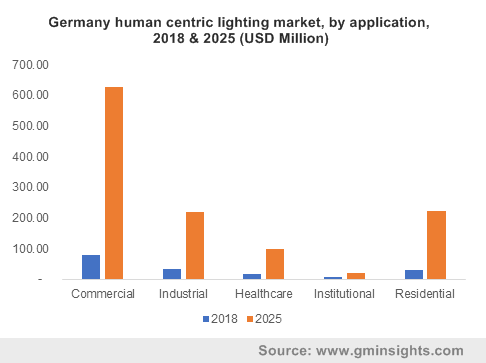Rising demand for energy savings to fuel human centric lighting market expansion
Publisher : Fractovia | Published Date : 2019-07-08Request Sample
Human centric lighting market is projected to grow steadily from 2019 to 2025, claims the latest research report compiled by Global Market Insights, Inc. Rapid development of the infrastructure sector and introduction of smart homes fueled by home automation has propelled the need for human centric lighting (HCL) across a plethora of end users including residential areas, commercial complexes, healthcare sectors, industrial areas and educational institutions.
Germany human centric lighting market, by application, 2018 & 2025 (USD Million)

Light’s spectral content and its intensity affects the human circadian rhythm, for example, the usage of blue light at night may undermine sleep due to the frequencies which suppress melatonin- a sleep inducing hormone. In contrast, when used during the day it excites a pigment called melanopsin, which sends signals to the brain, sets the body clock, and stimulates alertness.
Growing understanding of office ergonomics has prompted many employers to switch to LED options, to promote employee health and facilitate a positive work environment, thereby boosting human centric lighting market.
Healthcare sector is anticipated to be the leading consumer of human centric lighting products. These days human centric lighting is installed in hospitals across the globe, in a bid to assists patients suffering from an array of ailments, particularly patients of dementia and elderly patients. Due to mobility issues and illness, several patients spend time indoors and thus have restricted access to daylight that may disrupt their sleeping patterns. The use of optimal artificial lightings may compensate for the insufficient daylight exposure, thereby stabilizing the sleeping rhythm. The lighting also affects communication, eating habits, and anxiety thereby reducing dependency on medications.
The human centric lighting systems are extensively installed in commercial spaces, especially offices. Since the employees spend most of their time indoors, a poor workplace lighting can affect visual tasks, alertness, mood, sleep- wake pattern, and health. For example, a white light during the beginning of the day shift can help to reset our biological clocks. Similarly, in countries receiving less daylight during the winter months, “tunable white light” may reduce winter depression.
North America is poised to garner lucrative revenues in the forthcoming years, owing to its fast-paced infrastructural development and increasing demand for energy-efficient LEDs. Additionally, the shift from high power consuming traditional systems to smart technologies will bolster regional growth. Thus, the growing adoption of highly efficient and inexpensive LEDs, would fuel human centric lighting market size.
According to credible sources, the switch to efficient lighting in America has been rapid due to the shorter lifespan of the older bulbs. The citizens may replace older machines like refrigerator with an energy saving model but since the life of bulbs run out early, they are replaced by LEDs that save more than 80% of electricity.
Another prominent regional market of human centric lighting market is Europe. The extremely cold, windy winters in this region require the citizens to stay indoors thus increasing the consumption of electricity. Europe comprises Germany, UK, and Italy, all of which face adverse climate conditions, leading to an expansion of the regional industry.
According to the 10-year roadmap for European lighting industry, the region aims to shift focus to HCL to foster human health, performance, and wellbeing. Human centric lighting represents a big part of necessary change in the lighting industry in Europe, thereby ensuring a better future for more than 1000 companies.
Apparently, the European Commission proposes to set system requirements for the technical building systems, built-in lightings included. The report further stated that with the lighting controls and use of efficient means there will be around 60% of energy savings.
Owing to remarkable health benefits and energy efficiency, the demand for human centric lighting is set to grow in the coming times.